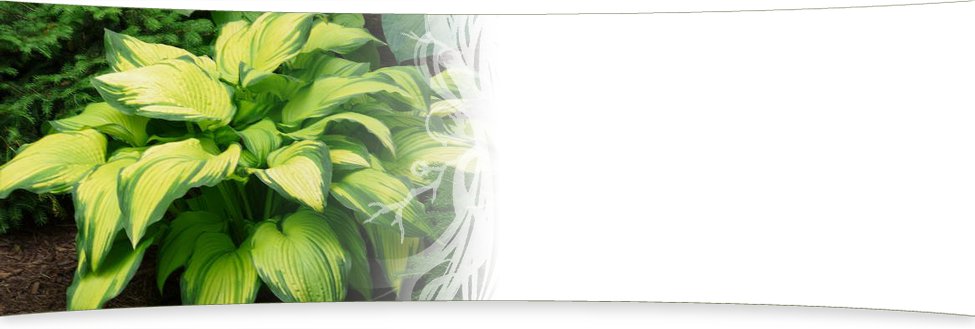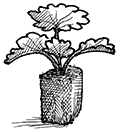
Hosta 'On Stage'
Highly streaked gold leaves with bright green margins have made Hosta 'On Stage' a favorite of the most compulsive hosta collectors.
Item: HosOnSt
$790
Closed for 2012.
Description
Originally known as Hosta 'Cho Ko Nishiki' from it's Japanese origin, Hosta 'On Stage' has become the more accepted name in the nursery trade here in the united states. Hosta 'On Stage' features pointed multi-toned gold leaves with grass-green edges that are more streaked than any hosta that we've seen. Many of the streaks along 'On Stage's' margin continue through the gold center to the base of the leaf. Leaves are neatly ribbed and the gold center becomes almost white as the season progresses.. Lavendar flowers are born on tall scapes in early summer. Fast grower, but emerges late in the spring.
Care
Widely known as shade plants, Hostas do not do well in deep shade. A high tree canopy or full exposure to the northern sky suites them well. Hosta 'On Stage' will also do well with full sun in the morning, but will most likely scorch if exposed to afternoon sun.
Hostas love deep rich soil. Use a garden or pitch fork to loosen soil to a depth of 12+ ". Amend soil heavily with materials such as shredded leaves, compost, or well-aged manure. A heavy layer of mulch can help keep moisture in, but can also harbor slugs one of hosta's primary pests. Soil PH should be relatively neutral so avoid acidifying organic materials like peat moss.
Hostas planted in rich soils need little fertilizer, however, a balanced fertilizer can be applied bi-monthly through mid summer. Do not fertilize late in the season. This produces a flush of growth that makes plants susceptible to winter damage.
Although hostas tolerate dry soils considerably well, adequate moisture should be provided to keep them healthy and looking their best. Dry conditions can severely slow growth and make plants more susceptible to leaf-burn. A deep watering of several hours is preferred over frequent shallow waterings.
Hosta 'On Stage' can be divided in spring through early summer or about a month before last frost date (giving roots time to heal). If dividing when if full-leaf, cut back leaves of each division to match the size of the root ball. A division with a large amount of leaves and small amount of roots will struggle.
Pests & Diseases
Slugs and snails are the primary pest. They can be controlled with chemicals (more effective) or beer traps (less effective). Chemical controls can be very toxic to pets and wildlife. Copper strips and diatomaceous earth have also been reported to be effective.
Deer love hostas! There are numerous different ways to discourage deer including fences, bitter chemicals applied to leaves, and a host of deer repellant devices. Smaller animals such as rabbits will occasionally bother hostas but this is the exception rather than the norm.
The HVX virus is one of the most destructive and contagious viruses of hostas. Numerous articles have been written about the symptoms and how to avoid contamination. Proper tool hygiene is imperative. Diseased plants should be immediately discarded. All Provenance Perennial Hostas (including Hosta 'On Stage') are virus indexed (tested). For more information, search for HVX in your browser. Other than the HVX virus, hostas are relatively disease free.
Deer love hostas! There are numerous different ways to discourage deer including fences, bitter chemicals applied to leaves, and a host of deer repellant devices. Smaller animals such as rabbits will occasionally bother hostas but this is the exception rather than the norm.
The HVX virus is one of the most destructive and contagious viruses of hostas. Numerous articles have been written about the symptoms and how to avoid contamination. Proper tool hygiene is imperative. Diseased plants should be immediately discarded. All Provenance Perennial Hostas (including Hosta 'On Stage') are virus indexed (tested). For more information, search for HVX in your browser. Other than the HVX virus, hostas are relatively disease free.
Shipping
Plant Size:

You are purchasing Hosta 'On Stage' as a commercial growers plug. Although smaller than the typical mail-order plant pots, the plants are often healthier and better-rooted. We have had great success planting these directly into our gardens. Within a month or two plants are indistiguishable from those that were transplanted at a larger size. The smaller pot size allows us to offer these designer plants at significantly discounted prices and low shipping rates. Plants will appear similar to the illustration.
Shipping:
We typically ship on Mondays (during the spring it sometimes takes a couple of days or more to get out all of our orders). Please notify us if your weather is approaching freezing or if it will be above 85 degrees. We do not recommend shipping or planting Hosta 'On Stage' in these conditions.
 Guarantee:
Guarantee:
We guarentee that your Hosta 'On Stage' will arrive healthy and thrive in your garden. Please contact us immediately if your Hosta 'On Stage' arrives damaged in shipping or if your plant fails to thrive within 90 days. We will gladly issue a full refund or send a replacement. To file a claim, please visit our Contact Us page and fill out the "Order Problem" form.
Not Available
Details
Family: Liliaceae
Scientific: Hosta 'On Stage'
Common Names: Hosta, Plantain Lily
Soil: Rich, well-drained loamy soils. Using a garden fork break up soil a foot deep and at least as wide as the mature plant ammending heavily with organic matter.
Size: One and a half inch commercial growers plug.
USDA Zone: 3-9
Width: 36
Height: 14
Flower Height: 48
Water Requirements: average
Sun Requirements: Light Shade to Part Sun. Avoid hot western exposures as well as deep shade. Several hours of morning sun with the remainder of the day in shade is ideal. Hostas do well on the norther side of fences and structures or under high-canopy trees.
Origin
Native Habitat: Ancestry originates from Northeast Asia
Patent Number: Not Patented
Parentage: Sport of Hosta montana
Breeder: Brought from Japan by Paul Aden, cir. 1986
Photo provided by Shady Oak Nursery
Patent Number: Not Patented
Parentage: Sport of Hosta montana
Breeder: Brought from Japan by Paul Aden, cir. 1986
Photo provided by Shady Oak Nursery

©2010 Provenance Perennial Gardens
18.216.190.167.CT:
18.216.190.167.CT: